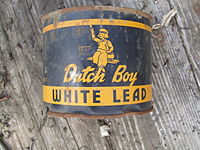
Photo from wikipedia
California's Safe Drinking Water and Toxic Enforcement Act of 1986 (Proposition 65) was designed to protect the state's populace from exposures to toxic levels of chemicals in consumer products, including… Click to show full abstract
California's Safe Drinking Water and Toxic Enforcement Act of 1986 (Proposition 65) was designed to protect the state's populace from exposures to toxic levels of chemicals in consumer products, including foods, by requiring businesses to warn the public about any of those hazards. There is, however, one qualification in the legislation, which is that warnings are not required if the source of that contamination is natural - as opposed to industrial. That qualification is especially problematic for lead because "natural" and "industrial" lead have a common origin, behave the same in the environment, and industrial lead contamination has been pandemic for millennia. As a result of that historic and on-going contamination, ambient lead levels in the biosphere may be orders of magnitude above natural levels, limiting comparisons of "natural" v. "industrial" lead concentrations in products. Further complicating those comparisons are reports of erroneously high measurements of lead concentrations in the biosphere due to sample contamination during collection, storage, and analysis. Some of those problems may be addressed with measurements of lead concentrations using rigorous trace metal clean techniques. These techniques often yield lead concentrations that are below the Act's maximum exposure in foods and non-foods of 0.5 µg/day, eliminating the need for a public alert. Those techniques have also been used to derive natural lead concentrations in a few organisms (marine fish, humans, rats, and dandelions), which range from 2-fold to 100-fold below ambient levels. But extrapolating from those few determinations to establish natural lead levels in other organisms is complicated and often inappropriate. Complementary stable lead isotopic composition measurements have also been used to estimate the percent of natural and industrial lead in some consumer products, including foods, wine and dietary supplements. These measurements, however, require the isotopic compositions of both the "natural" and "industrial" lead end-members, which may be poorly defined. In addition, the global market has further complicated identification of the "industrial" lead end-member, because lead contamination of foods can occur during production, harvesting, storage, shipping, processing, and packaging - which can happen in different locales within a country, different countries, and even different continents.
Journal Title: Journal of agricultural and food chemistry
Year Published: 2020
Link to full text (if available)
Share on Social Media: Sign Up to like & get
recommendations!